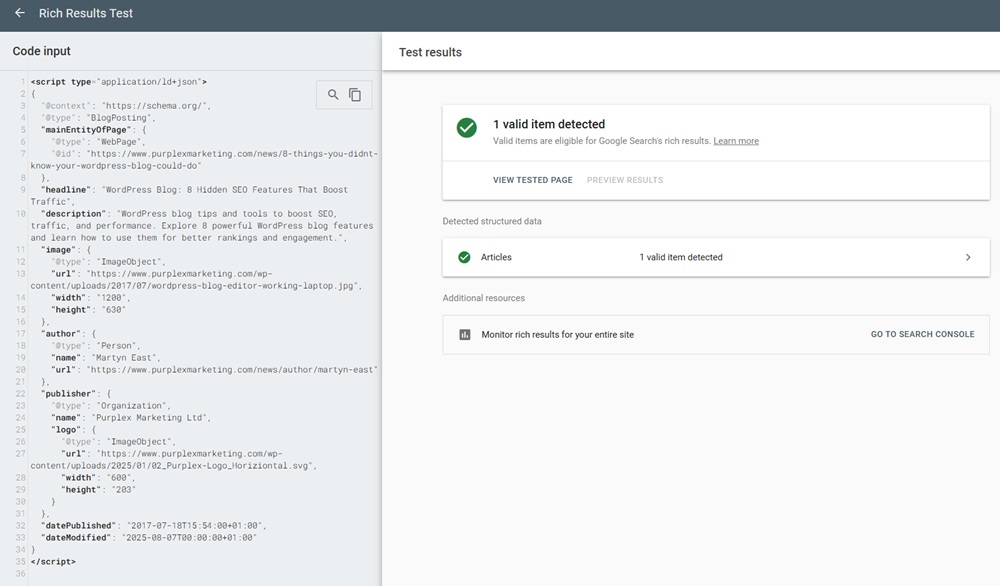Back
WordPress Blog: 8 Hidden SEO Features That Boost Traffic
Your WordPress blog could be doing much more for your business than just holding articles. In 2025, WordPress remains one of the most powerful content tools, but only if you’re using it properly. From improving SEO visibility to driving real web traffic and leads, your blog has the potential to work harder for your brand.
Here’s how to make your blog count:
- Improve Google rankings with structured, keyword-rich content
- Feed fresh content into social media and email campaigns
- Support Core Web Vitals, schema markup, and voice search
- Convert readers into leads with targeted calls to action
- Use WordPress features and plug-ins that many businesses ignore
8 WordPress Blog Features You Should Be Using in 2025
1. Optimised Blog Categories for UX and SEO
WordPress lets you organise your blog posts by topic. Clear categorisation improves user navigation and helps search engines understand your site structure. Use relevant category names with SEO-friendly slugs and internal linking between posts.
2. Schema Markup via WordPress Plugins
Modern blogs need structured data to appear in Google’s rich results. Use plugins like RankMath or Yoast to apply BlogPosting schema, FAQs, breadcrumbs, and author markup, no coding needed.

Valid schema markup detected for a WordPress blog using Google’s Rich Results Test.
3. AI-Driven SEO Tools Built into WordPress
In 2025, tools like RankMath Pro and Yoast SEO Premium will integrate AI to suggest content tweaks in real time based on live SERPs and competitor content. These can auto-detect focus keywords, internal link opportunities, and meta optimisation tips.
4. Gutenberg Blocks for Dynamic Layouts
The WordPress block editor lets you build interactive blog layouts. Add tables, accordions, call-outs, videos and reusable blocks to keep users engaged. It’s mobile-first and Google-friendly.
5. Mobile Speed Optimisation with Caching and CDNs
Speed is essential. Use WordPress tools like LiteSpeed Cache, WP Rocket, and Cloudflare integration to optimise for mobile-first indexing and CLS scores.

6. Newsletter Integration with CTAs
Turn readers into subscribers by embedding Mailchimp, HubSpot, or Brevo forms directly into your blog. You can also run gated content (like downloadable PDFs) for lead generation.
7. Multiple Author Profiles for E-E-A-T
Google’s algorithm now heavily favours clear author attribution. WordPress lets you show bios, social links, and expertise for each author, supporting Google’s Experience, Expertise, Authoritativeness, Trustworthiness criteria.
8. Performance Tracking via Google Site Kit
Google Site Kit for WordPress pulls real-time data from Analytics, Search Console, PageSpeed Insights and Tag Manager. Use it to review which blog posts drive traffic and conversions.
WordPress Blog Feature Comparison Table
| Feature | Purpose | Recommended Tool/Plugin |
| Category Optimisation | Improves content discovery and SEO | Native WordPress UI |
| Schema Markup | Rich results, Google AI Overview visibility | Yoast, RankMath |
| Mobile Speed | Improves page load and rankings | WP Rocket, LiteSpeed, Cloudflare |
| SEO AI Suggestions | Improves keyword relevance | RankMath Pro |
What else should I know about WordPress blogs?
WordPress is more than a blogging platform; it’s a full CMS capable of driving traffic, improving rankings, and generating leads. In this section, we’ll answer the most common questions we get about WordPress blogs and their real-world use in digital marketing.
Are WordPress blogs still effective for SEO in 2025?
Yes, if properly structured and regularly updated. Google values fresh, useful content and WordPress gives you the tools to meet those expectations.
What blog length is ideal for SEO?
Aim for 1,200–2,000 words per blog post. Long-form content tends to perform better in competitive niches.
How often should I post new blogs?
At least once per month, but ideally every 2 weeks. Consistency is more important than volume.
Can a blog post rank better than a web page?
Yes. Blog posts often attract more inbound links and rank faster for long-tail keywords.
Should I use categories or tags?
Categories are more important for structure and navigation. Use tags sparingly and only for closely related topics.
What’s better: Yoast or RankMath?
RankMath currently offers more advanced SEO features than most free plugins, including AI analysis, built-in schema, and automation. We’re not affiliated with or paid by RankMath, this recommendation is based purely on practical use and performance in client campaigns.
Let Your Blog Work Harder for Your Business
Your WordPress blog isn’t just a place for company updates. It’s a high-impact marketing tool if used correctly. By making small changes like structured categories, schema implementation, and SEO-friendly content layout, you can turn your blog into a traffic and lead-generation machine.
If you’re unsure where to start or want to assess the potential of your existing website and blog setup, we can help.
Ready for a free blog audit?
We’ll review your WordPress setup, blog content, and SEO structure and give you tailored feedback at no cost.
Let’s talk
If you’d prefer to speak to a member of the team:
- Call us on 01934 808132
- Email: grow@purplexmarketing.com
- Or send us a message via our contact page
Let’s turn your blog into a results-driven tool that grows your business.
This entry was posted in Digital Marketing





